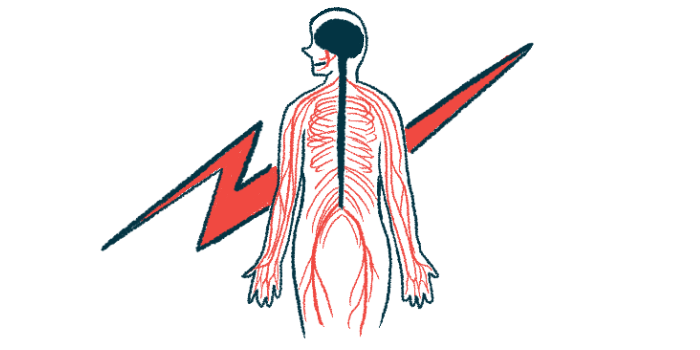High Incidence of Pain in NMOSD Is Mostly Nerve-related
Researchers in China analyzed factors influencing NMOSD-related pain

The incidence of pain in adults with neuromyelitis optic spectrum disorder (NMOSD) is high and was reported as the first sign of an inflammatory attack in half of patients, according to an examination of medical records.
Neuropathic (nerve-related) pain, marked by uncomfortable burning or tingling, was the most common type of pain reported, but treatments lacked efficacy in more than half of the cases.
The findings also showed that the level of disease-causing anti-AQP4 antibodies in the bloodstream was the only independent risk factor for NMOSD-related pain.
The study, “Pain in neuromyelitis optic spectrum disorder,” was published in the journal Multiple Sclerosis and Related Disorders.
Most NMOSD cases are triggered when self-reactive antibodies target the AQP4 protein on the surface of astrocytes, a cell type that provides support for nerve cells that send electrical signals. Immune-mediated damage to AQP4 leads to recurrent episodes of inflammation of the spinal cord (myelitis) and the optic nerve (optic neuritis), which connects the eyes to the brain.
Pain is a common NMOSD symptom, with eye pain, headache, neuropathic pain, and painful involuntary muscle contractions being the ones described most. However, studies systematically investigating pain in NMOSD are limited.
Now, researchers in China explored the incidence, clinical characteristics, and treatment of pain in NMOSD and analyzed the factors influencing NMOSD-related pain.
Data were gathered from the medical records of 145 adults with NMOSD, with an average age of about 45 years, of whom 127 were women and 18 were men. Among them, 106 (73.1%) tested positive for anti-AQP4 antibodies.
Imaging analysis found 94 cases (64.8%) with optic nerve involvement, 128 cases (88.3%) with spinal cord inflammation, and 82 (56.6%) with brain lesions. Pain was reported by 117 patients (80.7%) beginning at an average age of 37.9 years, of whom 91 (77.8%) were anti-AQP4 antibody-positive.
Neuropathic pain was the most common type of NMOSD pain reported (79.5%), followed by optic neuritis-related eye pain (31.7%), then headaches (16.2%).
Patients describe their pain
Pain descriptions varied, with the most common feeling being band-like constriction (44.4%), followed by needle puncture sensations (31.6%), then burning (27.4%), electric shock (17.1%), suffocation (15.4%), and freezing (5.1%). Pain severity also varied, with 10.2% reporting severe pain, 77.8% moderate pain, and 12% mild pain, most commonly in the lower limbs and trunk (34.2%), followed by the neck/shoulder (23.1%) and upper limbs (12.4%).
Lesions on MRI scans corresponded to neuropathic pain in 90 patients, particularly those with spinal cord inflammation. All 21 episodes of painful muscle contractions were related to myelitis. In those with headaches, lesions were found in the optical nerve, brain stem, or spinal cord in the neck.
Pain was reported as the first symptom of 103 recurrent NMOSD attacks occurring in 70 patients (48.3%), followed by limb numbness, weakness, nausea, and vomiting as the first symptom. Eye pain was reported as the first symptom in 20 cases, and eye pain duration lasted 2–15 days. Headache was the first symptom in 18 individuals.
Statistical analysis revealed that anti-AQP4 antibody levels were the only independent risk factor of NMOSD-related pain.
Factors that did not appear to influence NMOSD pain included age, sex, age at onset, disease course, annual recurrence rate, disability scores at last follow-up, site involvement, the presence of other autoimmune diseases or related antibodies, or first symptoms.
Pain was treated by pain relievers (analgesics) in 70 cases, while 47, including all patients with related eye pain, did not take these medications. More than half (54.3%) required two or more painkillers.
Pain also was relieved with on-demand hormone treatment in 39 cases and gamma globulin therapy to remove self-reactive antibodies in four patients. Headache was treated with oral gabapentin and/or pregabalin. Overall, the efficacy rate of pain treatment was 83.3%.
Most patients (95.2%) experiencing painful muscle contractions received anti-seizure medications, with an efficacy of 85%. Neuropathic pain was treated with various available medicines, but the efficacy rate was 46%.
Among those who failed to respond to treatment, nine of 21 experienced relief with the immunosuppressant rituximab and three of 11 with the antibody therapy tocilizumab.
According to the researchers, “the incidence of pain in patients with NMOSD is high,” and anti-AQP4 antibody level was an “independent risk factor for NMOSD pain.”
“The curative effect of [neuropathic pain] is poor,’ they added, and it is “necessary to diagnose early and treat pain in NMOSD,” they added.







